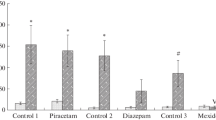The effects of Semax on the formation of a conditioned active avoidance reaction were studied in rats using different experimental models. I.p. administration of Semax at a dose of 0.05 mg/kg was found to accelerate the acquisition of a one-way conditioned avoidance reaction in a model of an active pain stimulus avoidance reflex in which the animals had to jump onto a shelf. In animals trained in a shuttle box, the peptide increased the threshold current required to provoked movement of the rats across the chamber and slowed acquisition of a two-way active avoidance reaction. Semax stimulated reproduction of the avoidance reaction in the shuttle box in rats after functional impairment induced by acute changes in cause-effect and spatial relationships in the experimental environment. These data support the view that this peptide has nootropic properties.
Similar content being viewed by others
References
I. P. Ashmarin, B. N. Nezavibat’ko, N. F. Myasoedov, et al., “The nootropic analog of adrenocorticotropin 4-10 – Semax (15 years of experience in its development and study),” Zh. Vyssh. Nerv. Deyat., 47, No. 3, 420–430 (1997).
T. A. Voronina and R. U. Ostrovskaya, “Methodological recommendations for studies of the nootropic activity of pharmacological substances,” in Handbook for the Experimental (preclinical) Study of New Pharmacological Substances), V. P. Fesenko (ed.), Remedium, Moscow (2000), pp. 153–158.
T. A. Voronina and S. B. Seredenin, “Methodological recommendations for the study of the tranquilizing (anxiolytic) activity of pharmacological substances,” ibid., pp. 126–130.
V. M. Getsova, N. V. Orlova, A. A. Folomkina, and V. N. Nezavibat’ko, “Effects of an ACTH analog on learning and memory processes in mice,” Zh. Vyssh. Nerv. Deyat., 38, No. 6, 1041–1047 (1988).
K. O. Eremin, V. S. Kudrin, I. A. Grivennikov, et al., “Effects of Semax on the dopaminergic and serotoninergic systems of the brain,” Dokl. Akad. Nauk., 394, No. 1, 130–132 (2004).
D. M. Ivanova, N. G. Levitskaya, L. A. Andreva, et al., “Effects of Semax on pain sensitivity in animals in various experimental models,” Dokl. Akad. Nauk., 388, No. 3, 416–419 (2003).
A. N. Inozemtsev, I. G. Kapitsa, T. L. Garibova, et al., “Comparison of the effects of nootropes and anxiolytics on functional impairments to an avoidance reaction,” Vestn. Mos. Gos. Univ. Ser. 16. Biologiya, No. 3, 24–30 (2004).
A. N. Inozemtsev and L. L. Pragina, “Methodological approaches to stress-inducing factors for studies of nootropic influences on learning and memory,” Vestn. Mos. Gos. Univ. Ser. 16. Biologiya, No. 4, 23–31 (1992).
Kh. Yu. Ismailova, T. M. Agaev, and T. P. Semenova, Individual Characteristics of Behavior, Nurlan, Baku (2007).
N. M. Kiseleva, A. V. Novoseletskaya, A. N. Inozemtsev, et al., “Neurochemical studies of the mechanism of action of a thymic polypeptide (Tactivin) in emotional stress,” Vestn. Mos. Gos. Univ. Ser. Meditsina, No. 4, 143–148 (2011).
N. G. Levitskaya, D. A. Vilenskii, N. Yu. Glazova, et al., “Studies of the effects of Semax on the severity of the depressive components of behavior in white rats in various experimental models,” Vopr. Biol. Med. Farm. Khim., No. 4, 46–51 (2011).
N. G. Levitskaya, N. Yu. Glazova, E. A. Sebentsova, et al., “Studies of the spectrum of physiological activities of the heptapeptide ACTH (4-10) analog Semax,” Neirokhimiya, 25, No. 1–2, 111–118 (2008).
S. V. Litvinova, A. N. Inozemtsev, V. V. Aristova, et al., “Effects of fluoxetine on the interaction of the serotoninergic and endogenous opioid systems on correction of cognitive functions and formation of tolerance to the actions of morphine,” Narkologiya, 4, No. 76, 15–21, (2008).
S. V. Litvinova, A. L. Kalyuzhnyi, A. N. Inozemtsev, and V. V. Shulgovskii, “Effects of piracetam on the interaction of the monoaminergic and endogenous opioid systems of the brain in rats with different sensitivities to the actions of morphine,” Narkologiya, 3, 12–20 (2007).
R. U. Ostrovskaya, T. A. Gudasheva, T. A. Voronina, and S. B. Seredenin, “The original nootropic and neuroprotective agent Noopept,” Exp. Klin. Farmakol., 65, No. 5, 66–72 (2002).
M. A. Ponomareva-Stepnaya, V. N. Nezavibat’ko, L. V. Antonova, et al., “An ACTH4-10 analog and long-acting learning stimulator,” Khim.-Farm. Zh., No. 7, 790–795 (1984).
A. Cavoy, A. Ennaceur, and J. Delacour, “Effects of Piracetam on learned helplessness in rats,” Physiol. Behav., 42, 545–549 (1988)
D. De Wied, “Neuropeptides in learning and memory processes,” Behav. Brain Res., 83, No. 1–2, 83–90 (1997).
A. N. Inozemtsev, T. L. Garibova, I. G. Kapitsa, and T. A. Voronina, “Effects of nootropics and anxiolytics on repeated functional disruptions of avoidance responses in rat,” Eur. Neuropsychopharmacol., 15, No. 2, 201–202 (2005).
I. Izquierdo and R. D. Dias, “Effect of ACTH, epinephrine, betaendorphin, naloxone and of the combination of naloxone or betaendorphin with ACTH or epinephrine on memory consolidation,” Psychoneuroendocrinology, 8, No. 1, 81–87 (1983).
K. B. Kumar and K. S. Karanch, “Effects of ACTH and ACTH 4-10 on aversive memory retrieval in rats,” J. Neural. Trans. Gen. Sect., 101, No. 1–3, 223–229 (1995).
W. Pohle, A. Becker, G. Grecksch, et al., “Piracetam prevents pentilenetetrazol kindling-induced neuronal loss and learning deficits,” Seizure, 6, No. 6, 467–474 (1997).
M. A. Saavedra, N. Avarca, P. Arancivia, and V. Salinas, “Sex differences in aversive and appetitive conditioning in two strains of rats,” Physiol. Behav., 47, 107–112 (1990).
O. L. Stratton and A. J. Kastin, “Increased acquisition of a complex appetitive task after MSH and MIF,” Pharmacology, 3, 901–904 (1975).
T. B. Van Wimersma Greidanus, “Effects of MSH and related peptides on avoidance behavior in rats,” in: Frontiers in Hormone Research, T. B. Van Wimersma Greidanus (ed.), Karger, Basel (1980), pp. 129–139.
Author information
Authors and Affiliations
Corresponding author
Additional information
Translated from Zhurnal Vysshei Nervnoi Deyatel’nosti imeni I. P. Pavlova, Vol. 63, No. 6, pp. 711–718, November–December, 2013.
Rights and permissions
About this article
Cite this article
Inozemtsev, A.N., Agapitova, A.E., Bokieva, S.B. et al. Differently Directed Influences of Semax on the Formation and Functional Impairments of an Active Avoidance Reaction in Rats. Neurosci Behav Physi 45, 173–178 (2015). https://doi.org/10.1007/s11055-015-0055-2
Received:
Accepted:
Published:
Issue Date:
DOI: https://doi.org/10.1007/s11055-015-0055-2



